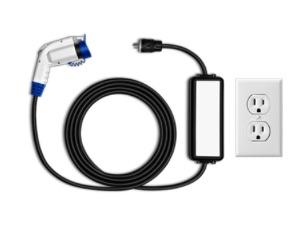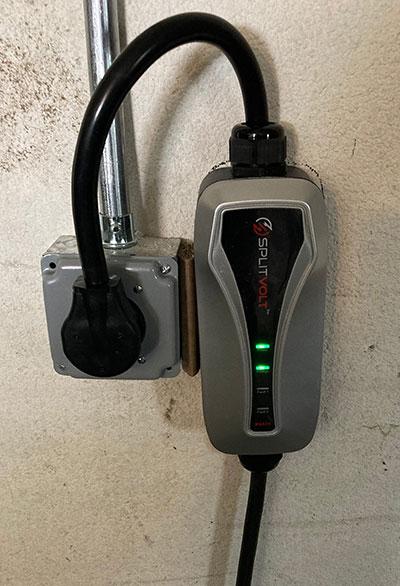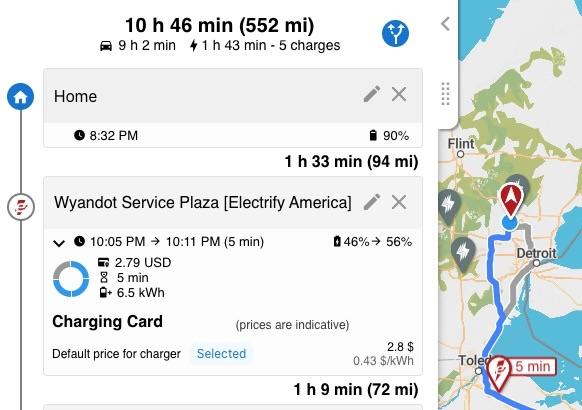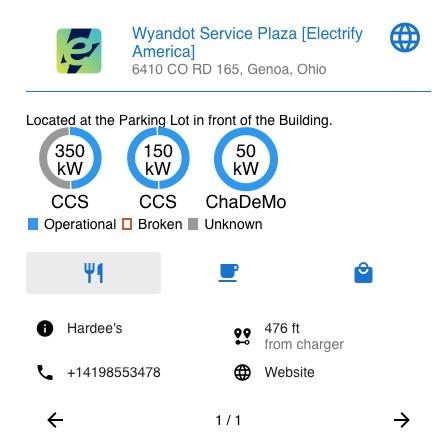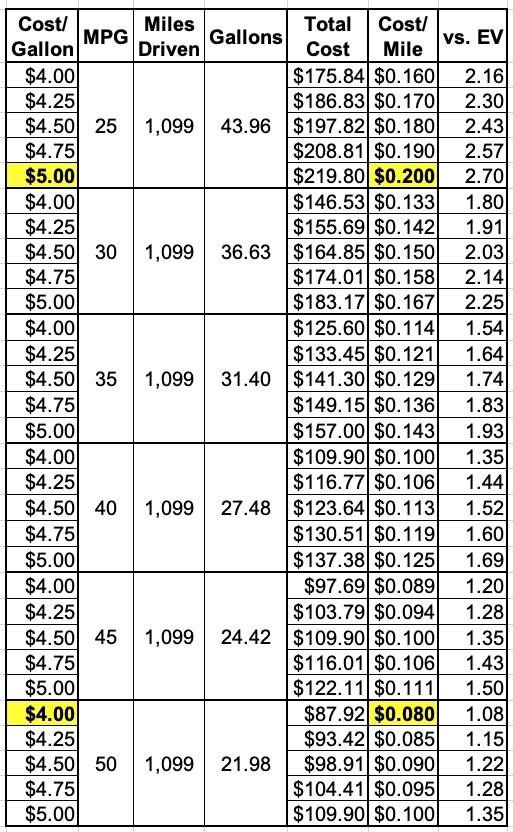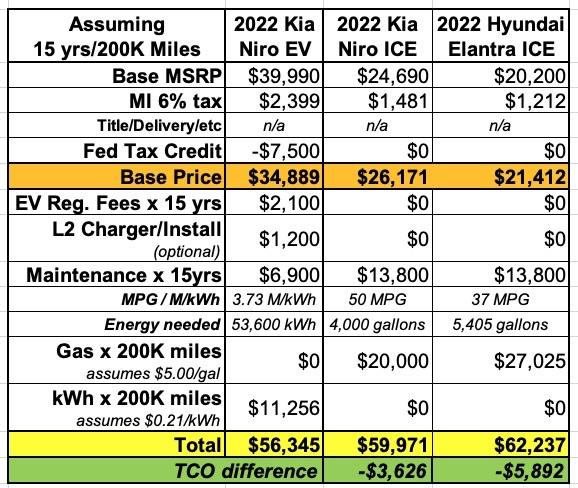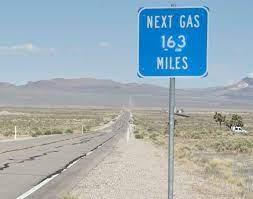Off-Topic: Everything (well, a bunch of stuff, anyway) you wanted to know about driving an EV but were afraid to ask!
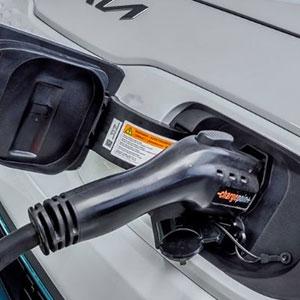
Regular readers may have noticed that I barely posted anything on the site last week, with good reason: I was out of town. I drove out to DC for a few days, ostensibly to attend the annual National Institute of Health Care Media (NIHCM) Awards Dinner, where I was a finalist in the Digital Media category this year.
(I didn't win, but that's OK...the competition was extremely impressive and it really was an honor just to be nominated, really!)
This was the fifth time I've visited the nation's capital, but the first time that I've driven. It's also the first road trip I've taken in an electric car, a brand-new 2022 Kia Niro EV (it replaced my 17-year-old Hyundai which was so badly rusted underneath that my mechanic was surprised it survived the past winter).
I don't often post blog entries about non-healthcare related issues, but I've had a lot of folks express curiosity about what it's like owning/driving an EV in the real world, so I figured this trip (which was, after all, for a healthcare awards dinner, and I also had healthcare policy meetings with a couple of folks on Capitol Hill) would be a good case study to give some thoughts on the subject.
Ten years ago, there weren't many electric car options for most people in the U.S. You had Tesla at the high end and the Nissan Leaf at the mass market end. There have been other models available, of course, such as the BMW i3 (introduced in 2013), Kia Soul (2014), the Chevy Bolt (2016) and so forth, but owning an EV was still seen as an extreme rarity in most of the country.
Over the past few years, however, the EV industry has exploded, both in terms of battery technology advancement, prices coming down (thanks in large part to the EV tax credit included in the 2009 American Recovery & Reinvestment Act of 2009), and more carmakers jumping into the EV market. As of 2022, there are now over 100 electric vehicle models available in the U.S. market. and over half of U.S. adults say they're at least willing to consider buying an EV as their next vehicle. And that survey was taken before Russia invaded Ukraine, causing gas prices in both the U.S. and around the world to spike to over $5/gallon in much of the country.
I had planned on holding off another year or two before making the move, and the current supply chain problems plaguing automakers globally made this a terrible time to buy a new car, but my most recent repair problems with my old Hyundai left me with no choice. I had to replace my car, and I decided to go ahead and take the plunge.
I pledged years ago that my next car would be at least partly electric. There are basically three types of EVs: Hybrids (HEVs), Plug-in Hybrids (PHEVs) and Battery Electric Vehicles (BEVs).
Hybrids (HEVs) still run on gasoline only, but are assisted by an electric motor. These have been around the longest; the most well-known example of this is the Toyota Prius, which has been available in the U.S. since 2001.
That's not what most people think of as an electric car, however; it's more like a super-efficient Internal Combustion Engine (ICE) car. I considered an HEV when I bought my last car in 2005, but decided against it at the time.
Plug-in Hybrids (PHEVs) literally have both a Battery Pack and an ICE crammed into the same car. They're designed to be charged like a full EV (thus the "Plug-in" moniker) ...but the battery pack is pretty small, so they can only drive around 20 - 50 miles on a charge before switching over to the ICE. At that point they operate more like a HEV, and can drive a couple hundred miles on regular gasoline. The Chevy Volt (introduced in 2010, discontinued in 2019) was the best-known PHEV for years, but these days there are dozens of PHEV models available.
The biggest advantage of a PHEV is that you can run on pure electric power for most day-to-day driving (most people don't drive more than 30-40 miles per day on average anyway) ...with the peace of mind of knowing that if you ever max out on the range, you still have a standard gas engine to use for long-distance driving/road trips and the like. The idea is that PHEVs are the best of both worlds.
I seriously considered getting a PHEV since I hardly ever go on long road trips. However, some of the upsides of PHEVs are also downsides. For instance, the EV driving is less efficient than it should be because you're still lugging around hundreds of pounds of ICE parts even though you hardly ever use them. There's less maintenance required on those ICE parts because you use them so rarely, but you still have to have them maintained from time to time. In other words, you have to worry about all the headaches of traditional car maintenance/repairs plus the additional parts included with an EV.
Ironically, the fact that you may not ever touch the gasoline in a PHEV can itself a problem because gasoline only has a shelf life of three to six months before it goes bad and starts damaging the car's engine. In short, PHEVs can also be considered to have the worst of both worlds.
If I was looking at a new car, say, five years ago, I probably would've settled on a PHEV anyway...but given the huge battery and charging infrastructure advances since then, the ARRA's federal tax credit, the recent gasoline price spikes and of course my desire to wean myself off of fossil fuels as much as possible, I decided to take the plunge and jump head first into the full EV experience.
A Battery Electric Vehicle (BEV, or simply EV) is fully electric, with a large, rechargeable battery pack and no gas engine at all. 100% of the energy is via the electric grid (or via regenerative braking, which I'll explain below). BEVs produce zero emissions whatsoever. This is the future of the auto industry, and EVs are taking off like mad this year.
I test drove several EVs before deciding on the Kia Niro. I had assumed I would just get a Chevy Bolt, since I was hoping to buy a union-made car this time around; unfortunately, when I actually test drove the Bolt (both the Bolt EV and its larger sibling, the Bolt EUV), I just honestly wasn't comfortable--it's a fine car I'm sure and many people love theirs (including my brother-in-law), but it just wasn't wide enough for me and the center console felt awkward.
On top of this, this spring turned out to be the worst possible time to look at a Chevy Bolt due to the ongoing battery recall plaguing General Motors over the past year or so. It turned out that I couldn't have even bought the car I was test driving if I had wanted to, as GM had a block placed on 2022 model sales at the time.
I also looked at a few other models including the Nissan Leaf. I actually liked the Leaf a lot; it was comfortable and pretty inexpensive (especially after the federal tax credit, which I was surprised to discover Nissan still qualifies for). However, there were two problems with the Leaf which were deal-breakers for me: First, it has a long history of problems with the battery overheating due to not having a liquid cooling system. Second, the Leaf uses the "CHAdeMO" fast-charging standard instead of the "CCS" standard:
CHAdeMO
This is the first of three types of connectors currently present on EVs and first introduced. Originally it was implemented to be the industry standard, developed through the collaboration of five different Japanese automakers.
As a result, the CHAdeMO connector remains affluent in Japan and on EVs from Japanese manufacturers. This includes automakers such as Toyota, Mitsubishi, Subaru, and Nissan.
CCS
Shortly after the CHAdeMO was introduced, a second connector called the Combined Charging System (CCS) was implemented as an additional charging standard.
Where CCS connectors differ from CHAdeMO, is that they allow for AC/DC charging on the same port. CHAdeMO-equipped EVs require an additional J1772 connector cord to achieve Level 1 or 2 charging.
This connector is the preferred mode of charging amongst European and American automakers, including BMW, Ford, Jaguar, GM, Polestar, Volkswagen, and even Tesla. Additionally, CCS is will be present on the upcoming Rivian EVs.
The short version is that this is sort of a VHS-vs-Betamax situation, where one industry standard (CCS) is making the other one obsolete...and in fact even Nissan is phasing out CHAdeMo in favor of CCS in their replacement for the Leaf.
In the end, I went with a Kia Niro EV...which surprised the hell out of me, because the last time I test drove a Kia (again, over 17 years ago), it felt like a cheap knockoff brand...at the time the materials, build quality etc. just felt shoddy and the car felt underpowered, even for an entry-level sedan.
However, Kia has massively upped their game since then, and I was pleasantly surprised to find the Niro felt very solid across the board. I fell in love right away. It's a bit more expensive than I had budgeted for, but the $7,500 tax credit (plus the projected Total Cost of Ownership (TCO)...see below) knocked it down into my price range (if just barely).
OK, now comes the big question on everyone's mind: What's the real-world experience of owning and driving a "pure" EV like, especially when it comes to "range anxiety" and charging the battery?
Well, first of all, the official driving range of EVs varies widely by make, model and year. Again, as battery technology has advanced, the average ranges have increased dramatically, but at the moment one of the the shortest-range new fully-electric vehicles in the U.S. is the smart EQ fortwo, which can only drive 81 miles on a single charge, while the 2022 Lucid Air Dream Edition can supposedly go a whopping 520 miles...if you're willing to pay $170,000 to get it.
My 2022 Kia Niro EV is officially rated at 239 miles per full charge, although that can range between as low as perhaps 180 or as much as nearly 300 miles depending on the weather, temperature, driving conditions, speed and so forth.
Honestly, the charging issue really breaks out into two scenarios: Day to day driving and road trips.
DAILY DRIVING:
The biggest question here is whether or not you have a garage, your own outdoor electrical outlet, or at least an outlet which you have regular access to. If you live in an apartment building or some other scenario where you don't have your own outlet, that's a whole other discussion, although there are lots of companies already working on solutions for this as well.
If you do have a garage/your own outlet, however, the answer is simple: Charging an EV isn't a problem for daily driving at all.
There are three levels of EV charging available. The first two are available at home:
Level 1: Also known as "Trickle Charging," this is by far the simplest...but also the slowest. Every EV sold should include a Level 1 charging cable, which plugs into any standard, grounded, 120 Volt electrical outlet. Think of it as bigger, thicker USB cable. There's generally no installation or electrical work required unless the outlet isn't grounded properly (the third, rounded hole) or if the outlet shares the same circuit breaker as too much other stuff in the house.
The only downside to a Level 1 cable is that it's slow (thus the "trickle charge" label). Level 1 cables generally charge EVs at around 1.0 - 1.4 kW. My 2022 Niro EV has a 64-kWh battery pack, so it would take 45 - 64 hours to completely charge the battery from 0% to 100% full...or roughly 2 - 2 1/2 days. Of course, it's a terrible idea to let your battery run completely empty (just like you should never let your gas tank go completely dry), and you don't have to fully charge the battery either (in fact, this is usually not recommended...again, see below).
The exact charging time and rate will vary by model and outlet, but generally Level 1 charging adds 3-4 miles of range per hour. Since most people don't drive more than ~40 miles per day anyway, that means you can usually get away with partly charging the battery overnight (10 hours = 30 - 40 miles of range).
Level 2: This is the preferred charging level for most home charging. Level 2 cables can recharge EV batteries at anywhere between around 4.8 - 7.6 kW, depending on how many Amps your outlet produces and which cable you get. This basically amounts to ~5x faster than Level 1, or perhaps 15 - 35 miles of range per hour. You should be able to fully charge your EV from 0 - 100% in around 8 - 12 hours...basically, a full charge overnight. If you don't drive all that much, you could theoretically go up to week between charges, although most EV owners w/Level 2 chargers do so nightly or every few days.
There are two downsides to Level 2 charging: First, you'll likely have to have a 240 Volt wall outlet installed in your garage if you don't already have one (some houses have a 240V outlet in the garage already for a clothes dryer). This is something you may be able to do yourself if you know what you're doing with electrical work...but it's not something to be done lightly if you don't. That means hiring a professional electrician to install the outlet properly. One upside: 240V outlets are generally on their own separate circuit, so you don't have to worry about overloading it with other appliances.
In our case, we have a 240V "dryer" outlet in our laundry room which is next to the garage, so the electrician just had to run conduit through the ceiling and down the outer wall to the garage, then add an outlet there. It was a one-day job which cost us around $900.
The second downside is that you'll likely have to buy your own Level 2 charging cable. Some EV models include a Level 2 cable with the car, but others only provide a Level 1 cable. Level 2 cables cost anywhere from $250 - $700. The fancier ones include all sorts of bells & whistles like higher amperage (faster charging), wi-fi or even voice controls for remote scheduling, detailed digital displays, etc.
We didn't need any of that so we just went with a SplitVolt NEMA 10-30 24 Amp EV Charger for $280. It's actually portable but the main unit also has mounting holes on the back, so I mounted ours to the wall right next to the 240V outlet.
You may have noticed that the 240V outlet + the Level 2 charger set us back $1,200 above & beyond the cost of the car itself. However, some automakers include the Level 2 cable, and some are even bundling installation of the 240V outlet by a qualified electrician as part of the sale as well...and again, you don't have to get a L2 cable, that's just something I was more comfortable with (also, the 120V outlet in our garage uses the same circuit as about 1/3 of the rest of the house, which didn't seem like a wise idea).
I should also note that there was a 30% federal tax credit for L2 EV charger installation/equipment as well, but that expired at the end of 2021. However, lots of states have their own assorted EV incentives/rebates, as do some individual utility companies.
It's also important to know that all electric cars include a fantastic feature called Regenerative Braking:
The most noticeable difference between driving an electric vehicle and a conventional ICE vehicle is regenerative braking. Regenerative braking means the electric motor is operated in reverse, thereby applying a braking force through electromagnetism. This recaptures some of the vehicle's kinetic energy by charging the battery. Some electric vehicle models have specific driving modes that incorporate varying levels of regenerative braking.
Under normal driving conditions, an EV such as the Tesla Model S engages regenerative braking to slow the vehicle when the driver removes their foot from the accelerator. The “Standard” setting provides the maximum amount of regenerative braking power— it recaptures the most energy and reduces wear and tear on the brakes. Alternately, the “Low” setting incorporates a reduced regenerative braking force that recaptures less energy but allows the vehicle to coast farther than in the “Standard” mode.
I can't overstate how awesome regenerative braking (RB) is. The Kia Niro EV actually includes three levels of RB (or you can disable it entirely, though I can't fathom why anyone would do that). You can easily bump it up or down on the fly, like shifting gears with your fingers on a bicycle. In city driving, where you're constantly speeding up & slowing down, RB can regenerate as much as 50% or more of the electricity you use.
On the freeway, where you're often driving at a constant speed for long stretches of time, RB generates far less. Because of this, EV energy efficiency is actually the opposite of ICE cars: Instead of getting better fuel efficiency on the highway vs. city driving, it's the opposite.
As noted in the quote above, in addition to helping recharge the battery, RB also means less wear & tear on the brakes. I've heard from some long-time EV owners (mostly Tesla & Nissan Leafs) that they still haven't had to replace their brake pads after driving 100,000 miles or more!
Speaking of less maintenance, a fully-electric vehicle engine typically has just 20 moving parts as opposed to nearly 2,000 in a typical ICE vehicle! No spark plugs, oil changes, catalytic converter, carburetor, radiator, etc. to worry about. On average, Consumer Reports recently found that the average EV needs around $4,600 in lifetime maintenance vs. $9,200 for a typical ICE car.
For daily driving, as long as you have access to a standard outlet, driving an EV is really not much different from driving an ICE car...except that you'll never have to visit a gas pump again and you rarely have to use the brakes (except when you come to a complete stop).
Again, if you live in an apartment or otherwise have no access to an outdoor outlet near your car, it can be a lot trickier, but there are lots of solutions in the works for that. There's a growing network of L2 chargers popping up all over the place, however; many of these are free to use (at least for now), while others charge a fee either by the kWh or by the minute.
This brings me to...
ROAD TRIPS:
This is where things do get a bit dicier, depending on where you live...at least for the next few years.
Level 3: I mentioned above that there's three types of EV charging. The third one, Level 3, can not be installed in most residences due to the amperage required (100+)...and it would cost tens of thousands of dollars to do so anyway. L3 chargers are the closest equivalent to a "gas pump" there is in the EV landscape.
L3 chargers require 400 - 900 Volts. Not only is the amount of electricity delivered far greater than L1 or L2, but it also includes DC charging:
AC (alternating current) is an electrical current, or flow of charge, that periodically changes direction, i.e., it alternates. AC power can be generated from renewable sources that use rotating generators, such as wind or hydropower turbines. AC can also be efficiently transported over long distances—which is why virtually all of the world’s electricity grids use AC power, and why you can find AC power in your home and office.
DC (direct current) always moves in a straight line and can be generated by renewable power technologies such as solar panels. Among other things, DC can be used for energy storage and LED lighting. Batteries store DC power, and though you may have never realized it, every time you charge your laptop, the charger converts the AC power from the grid into DC power for your laptop’s battery.
In short, we get AC power from the grid and this is converted into DC power so it can be stored in batteries, such as the one used to power an EV.
When we talk about charging an EV, the main difference between AC and DC charging is where the conversion from AC to DC happens. No matter whether an EV uses an AC or DC charging station, the EV’s battery will still only store DC energy.
When you use a DC charging station, the conversion from AC (from the grid) to DC happens within the charging station—allowing DC power to flow directly from the station and into the battery. Because the conversion process happens inside the more spacious charging station and not the EV, larger converters can be used to convert AC power from the grid very quickly. As a result, some DC stations can provide up to 350 kW of power and fully charge an EV in 15 minutes.
Level 3 (DC Fast Charger) cables are even thicker than L2 cables due to the extra shielding, and the "nozzle" (plug) is even thicker & heavier, mainly because it actually has two separate prongs, as shown below:
While the article quoted above notes that the DC charging stations can theoretically provide up to 350 kW of power, most EVs aren't built to handle that much of a charge. The Kia Niro EV is limited to a maximum of 77 kW. In theory that suggests that you could fully charge it from 0 - 100% in 50 minutes, but batteries don't charge at a consistent rate:
So, in a nutshell, what is a Charging Curve? Essentially, it’s the change in speed that your car will charge at as it gets fuller and fuller. The rate that your EV charges depends on a number of factors, but the most important is what the state of charge is. In principle, when it’s nearly empty it charges quickly, and when it’s nearly full, it charges slowly.
Here's what it looks like for the 2019 Niro EV. I assume this is slightly different (improved?) for my 2022 model, but it should be pretty close:
As you can see, not only does the charging speed drop off as the battery's charge increases, but it doesn't do so consistently--it stays around the same pace for awhile, then drops suddenly, stair-stepping down until it's only around 10 kW when the battery reaches 95% charged.
Because of this (and for another reason; see below), most L3 DC chargers are set to automatically stop charging EV batteries once they reach an 80% state of charge. They do this because they don't want someone hogging the charger for another hour or so just to top off that last 20% when someone else could be using it.
That's ok, however...because there's a lot of EV & battery experts who say that charging the battery past 80% can damage (or at least shorten the life) of the battery pack anyway:
Why does it matter? Like cellphones and laptops, electric vehicles use lithium-ion batteries.
They degrade faster when they’re drained to zero and then fully charged. That’s a full charging cycle. As the battery degrades, it loses its maximum charging capacity and has a shorter life.
The advice from carmakers varies. For instance, Ford and Volkswagen said you should only charge to 100 per cent if you need your EV’s full range for a longer trip.
VW recommends charging to 80 per cent for daily driving, while Ford recommends charging to 90 per cent.
But General Motors and Nissan said there’s no problem charging their EVs to 100 per cent every time they’re charged.
I've read all sorts of debate about this issue--not only is there different recommendations from different carmakers, but it also seems to depend on the specific model and especially the year of the car, since the newer models have more advanced battery management features and most of them don't even allow you to access the "true" 100% full charge of the battery in the first place (that is, there may be a 10% "buffer" which most drivers are never able to access at all).
Even so, it's generally recommended not to hit 100% using a L3 charger if at all possible...and again, most of them won't let you do so anyway.
Level 3 DC Fast Chargers pretty much all cost money to use (which makes sense, seeing how they cost between $28,000 - $140,000 to install!). Some charge by the kWh (which makes a lot more sense). This can vary widely, but it seems to generally be somewhere in the $0.25 - $0.45 per kWh range. If you split the difference ($0.35/kWh) that would be around $22 for a full charge...except, again, you're almost never going to roll up to a DC charger with 0% left, and they generally won't let you charge more than 80% full anyway. A typical charge for a Kia Niro EV with a 64-kWh battery pack from, say, 20% to 80% full, would cost around $13.50 (60% x 64 kWh = 38.4 kWh x $0.35/kWh).
Other DC chargers charge per minute, which doesn't make much sense to me since, as noted above, the charging speed slows down as your battery gets increasingly charged. That would be like a gas station charging you by the minute but the gas pump nozzle starts out as thick as a firehose but gradually shrinks until it's as thin as a drinking straw when you top off the tank. Charging by the minute can actually cost less than by the kWh...but only if you plug into the charger when the battery is really low and then stop it when it reaches, say, 70% charged.
DC chargers also often include an additional per-minute fee after you're done charging in order to prevent you from staying plugged in & hogging the station...although they usually include a 10-minute grace period before the extra fee kicks in.
So, what does this look like in the real world?
Well, that's where my trip to DC (District of Columbia, not Direct Current!) comes in.
I drove a total of right around 1,100 miles round trip (~550 miles each way...I didn't do any driving once I got to the hotel), from Bloomfield Township, MI to Washington DC and back. I made a total of 9 charging stops along the way (in one case the session was interrupted and had to be restarted). Some of the stations charged by the kWh; others by the minute.
There are numerous EV charging networks in the U.S., but most are local/regional. The four major ones are Electrify America, EVGo, ChargePoint and of course Tesla's "SuperCharger" network, which is a whole different thing. All of the DC chargers I used were from Electrify America except for one EVGo station (that's the one where I had to restart the session).
The Charging Experience
The public charging experience itself is different from using a gas pump in several ways. First of all, instead of being in & out in 3 minutes flat, you're generally charging for 20 - 40 minutes on even a DC charger. Then again, you usually only need DC chargers when you're on a long road trip where you probably want to stretch your legs, take a bathroom break and grab something to eat anyway. Ironically, it's actually too fast in some cases since 20 minutes isn't really long enough to eat at a sit-down restaurant, and you don't want to start getting charged again after that 10-minute grace period.
Traditional "3 at every intersection" gas stations tend to not have a lot of extra room for parking lots, which is fine since they're designed for cars to drive in, gas up and get out quickly. Many of them have small convenience stores or a small carryout restaurant attached, but that's usually it. If they're located in a more rural area where there's a lot more land to work with, however, chains like Sheetz, which often include a full-size convenience store & restaurant have been adding L3 EV chargers alongside the gas pumps. I expect to see a lot more of this.
A major advantage of EV chargers is that unlike gas pumps, they don't require an underground gas storage tank, which can cost $500K or more. They also don't have to have an actual manned service station next to them--many EV chargers are located far away from any structures. This also means that EV chargers can be installed almost anywhere, as long as the electrical line can be run out that far. Many are showing up in parking lots of Wal-Marts, grocery stores, hospitals and so on.
One big downside is that the reliability seems to be a lot worse than most gas stations. A typical gas station might have 10 - 12 pumps, of which the odds are at least 11 of them are working at any given time. With EV chargers, my experience on this first road trip is that perhaps 1/3 of the charging units weren't working at any given time--either it wouldn't connect to the car or there was a problem with the payment being authorized before you could start charging. I assume these bugs will be worked out over the next couple of years.
Another drawback is that while gas pumps are almost always covered by a canopy/awning, public EV chargers, unless they're located in a parking garage, are typically out in the open. This makes charging your EV battery a bit of a pain when it's raining, although it's my understanding that the cables and end plugs are extremely well insulated so that there's no danger of electrocuting yourself or frying your car.
While EV chargers include standard credit card swipers, most of them are designed to work with a phone app for that network, which loads your account from your credit card in $10 increments. Having a membership in the network with a monthly fee also knocks a percentage off the price per kWh.
For my own trip, many people recommended that I download an awesome app for my phone which also works with Apple's CarPlay and Android Auto called A Better Route Planner. This app integrates with Apple or Google Maps; you plug in your starting and ending destination along with your EV model (so it knows how large the battery is, what the estimated range is, etc.) and ABRP will tell you exactly which EV chargers you should charge at.
It also tells you how many miles & how long each driving stretch and charging session will be, how many charging stations there are at each location, how fast they charge at, what the estimated cost will be and so on. You can enter or modify what you want your starting and ending state of charge is and it will recalculate based on the changes.
Hell, it even tells you whether each charger is working or broken, as well as how far away the nearest restaurant, coffee shop or hotel is to the foot!
(P.S. I also highly recommend installing another app called PlugShare.)
Since this was my first time making a long road trip in the Niro I played it safe and told ABRP to only let me drive about 100 miles between charging stops. This proved to be unnecessary for most of the trip but on the way back I did run into one occasion where I appreciated it: ABRP directed me to a charging station somewhere along the Ohio Turnpike which turned out to be located behind a locked gate in the parking lot of a closed factory...which, ironically, made electric trucks until just last month before being bought out by FoxConn. That's right: The one time that I was in any fear of my EV running out of power was when I was literally next to an electric vehicle factory.
Fortunately, because I had thought ahead, I was able to make it to the next charging station on my route without incident, but I admit it did make me a bit jumpy until I got there.
Here's how much time it took and how much it cost me for all of my charging sessions for both trips (the total cost includes taxes):
As you can see, I spent a total of $74.80 at the various public charging stations for a total of 227.61 kWh. That breaks out to just under $0.33 per kWh...which happens to be very close to the $0.35/kWh midrange I noted above. The most I paid was $0.46/kWh; the least was $0.17/kWh.
In addition, since I started my trip with the battery charged to a full 100% (again, you shouldn't do this regularly but it's fine once in awhile...and even recommended to do around once per month), I also topped it off once I got home to get a true measure of how much electricity the trip took, and how much it cost. DTE's residential rate here in southeast Michigan is 17.8¢/kWh, but when you include the various taxes/fees it ends up right around 19¢/kWh. That's another 31.5 kWh for a total of $81.47 for the round trip.
However, there's one other important factor: I mentioned earlier that Regenerative Braking regenerates a portion of the battery's charge as you drive. I also noted that it doesn't generate as much on a long road trip as in city driving, and sure enough, in this case the RB only generated about 20% of the total electricity used (~57 kWh vs. ~264 kWh charged externally). Still, that 57 kWh cost nothing because it was generated by the moving car itself. This alone saved me around $18 at $0.32/kWh.
In the end, what really matters is how much it costs to drive per mile. I mentioned earlier that the official range rating of the Kia Niro EV is 239 miles per full charge. This uses a combination of city & highway driving; if you take it at face value, 239 miles / 54 kWh = 3.73 miles/kWh. If I only charged off of my L2 home charger at $0.19/kWh, that would break out to 5.1¢ per mile.
For my trip to DC, which was virtually all highway driving, $81.47 for 320 kWh to drive 1,099 miles breaks out to 3.47 miles per kWh, or 7.4¢ per mile, with most of that being on the public chargers.
How does this compare to driving an ICE vehicle? My old 2005 Hyundai Elantra supposedly got 27 MPG city / 34 highway when it was brand new...but by the time I sold it I can't imagine it was averaging more than 25 MPG. However, it's unfair to compare a brand-new vehicle of any sort to an old gas-powered car. Fortunately, the Kia Niro is available in three models: ICE, PHEV and BEV. The 2022 ICE Niro has an official fuel efficiency rating of 53 MPG city / 48 highway. Let's call it around 50 MPG on average.
Average gas prices in the U.S. are around $4.76/gallon as of today, and $4.94/gallon in Michigan. In the table below, I look at gas prices ranging from $4.00 to $5.00, and ICE cars getting between 25 & 50 MPG. I then compared the average cost (in gas only, remember) per mile against my real-world EV 7.4¢ per mile:
As you can see, the best-case scenario (an ICE car getting a real-world 50 MPG on the highway at just $4.00/gallon, which I don't think can be found in any state at the moment) still would cost $88 in gas...8% more than my trip did. The worst-case scenario (if I had attempted to drive a car getting 25 MPG at $5.00/gallon) would have cost $220...2.7x as much. Some states are as high as $6/gallon or more, but Michigan, Ohio, Pennsylvania and Maryland (the four states I drove through last week) all average a bit below $5.00, so that seems pretty accurate.
What about total cost of ownership?
Well, let's suppose I drive the car a total of 140,000 miles over 10 years, with gas averaging $5.00/gallon over that time (I assume it will go down soon but will then go up over time due to inflation). Let's also assume that I get 90% of my electricity from my home 240V outlet and perhap 10% from public chargers. That would put the average price of electricity over that time at around 20.6¢/kWh (0.19 x 0.9 + 0.35 x 0.1 = 20.6).
In that scenario, the brand-new Kia Niro ICE would use around 2,800 gallons of gas which would cost around $14,000. Meanwhile, the Niro EV would use up around 37,500 kWh of electricity, costing ~$7,900. That's around $6,100 in TCO savings.
If I compared it against a more typical 2022 model. According to the U.S. Energy Dept., average fuel economy of all ICE Sedans, Wagons & Small SUVs was around 30 - 33 MPG. Let's call it 32 on average. That would mean a more realistic cost of ~$21,875 for ~4,400 gallons of gas...meaning an EV savings of nearly $14,000.
Add to that the supposed $4,600 in 10-year maintenance savings and that's anywhere between $10,700 and $18,600 in TCO savings over a ten year period vs. a traditional ICE vehicle.
Of course, there's also some extra costs involved:
- The $1,200 I spent on the 240V outlet and the L2 charger (optional, though)
- The additional $140/year state EV registration fee Michigan charges (among the highest in the country). Technically only $40 of this is to replace the lost gas tax revenue; the other $100 is just sort of...added on for no particular reason. Over 10 years (assuming it doesn't change) that's an extra $1,400.
Still, even if you subtract both of those, that's still a net TCO savings of between $8,100 - $16,000.
UPDATE: D'oh!! For someone so focused on the Total Cost of Ownership, I completely forgot to include the cost of the car itself! That's...kind of important.
- The 2022 Kia Niro EV has a base MSRP of $39,990; after that $7,500 federal tax credit that drops to $32,490.
- The 2022 Kia Niro ICE has a base MSRP of $24,690.
If you're just talking about base price, the ICE version costs $7,800 less after the federal tax credit...but once you include TCO, the EV version still ends up costing less, assuming you own and drive the car for at least 10 years or more.
As for the ICE Hyundai Elantra: In 2005, the Hyundai Elantra's base MSRP was $13,299. Seventeen years of inflation would have put that at around $19,687 today. As it happens, the 2022 ICE Hyundai Elantra's base MSRP is $20,200, with an official 37 combined MPG. That would theoretically require 5,405 gallons of gas to go 200,000 miles, costing a total of $27,025 in gas.
In the tables below I've summarized all three side by side. The first assumes that I were to purchase, own and drive each car for 10 years & 140,000 miles (the average U.S. driver drives around 14,263/year). The second assumes I drove each for 15 years & 200,000 miles:
Over ten years, the total cost of ownership of the Niro EV comes in slightly higher than either of the ICE cars. This is mostly due to that initial ~$15K - $20K pricing difference, along with the higher state registration fees for owning an EV and the L2 charger installation. Nearly all of this is cancelled out by the federal tax credit, reduced lifetime maintenance and savings on electricity vs. gas.
Of course, that L2 charger is optional; either way, the TCO is virtually identical across all three, just shy of $50K over a decade.
Over fifteen years & 200K miles, the total cost of ownership of the Niro EV is ~$3,600 lower than the $25K Niro ICE and ~$5,900 lower when compared to the $20K Elantra ICE. Again, if you don't include the L2 charger, the overall savings increases even more.
Of course, the Niro EV isn't the least expensive EV on the market either; you can get a 2022 Nissan Leaf for as little as $20,000 after the federal tax credit (assuming you're OK with the issues I noted above), and just yesterday General Motors announced that the 2023 Chevy Bolt will be priced starting at just $26,595, although Chevy no longer qualifies for the federal tax credit.
There's also the variables of electricity and gas pricing by state or even by county...the average price of gas ranges from $4.50 to $6.30/gallon at the moment depending on what state you live in, while the average price of residential electricity ranges from as little as 7.5¢ per kWh in Louisiana to as much as 27.6¢ per kWh in Hawaii. And, of course, both of these will fluctuate over the next 10 - 15 years.
The larger point is that EVs are finally competitively priced against ICE cars when TCO is taken into account (and often even when it isn't), and that trend should only continue over the next few years.
So, there you have it: For local, day-to-day driving, EVs are ready for prime time...as long as you have a garage or access to a regular outlet. For longer road trips, I'd say the EV market is almost there, with some additional infrastructure and standardization needed. In the more populated regions of the U.S. I'd say we'll be ready for prime time within two year or so. For more sparsely populated rural areas like Montana, Wyoming, the Dakotas, etc. it'll likely take a few years longer...but that's kind of a cliche already with gas cars already, isn't it?



